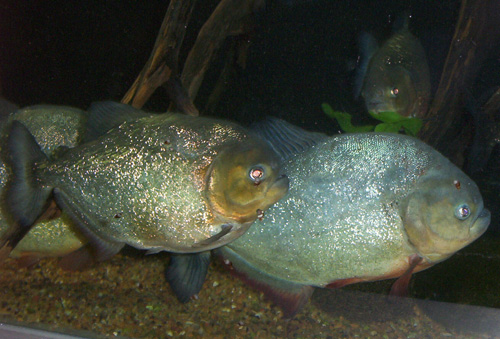 PIRAHNA
PIRAHNA
|
The name piranha may come from a hybrid language composed of Tupi Guarani languages; it may be a compound word made of the components pirá, meaning 'fish', and sanha or ranha, meaning 'tooth'. Alternatively, it may come from Tupi pirá (fish) and ánha (devil). Piranhas belong to the family of Serrasalmidae. Traditionally, only the four genera Pristobrycon, Pygocentrus, Pygopristcis and Serrasalmus are considered to be true piranhas, due to their specialized teeth. However, a further analysis showed that, if the piranha group is to be monophyletic, it should be restricted to Serrasalmus, Pygocentrus, and part of Pristobrycon, or expanded to include these taxa plus Pygopristis, Catoprion, and Pristobrycon striolatus. Pygopristis was found to be more closely related to Catoprion than the other three piranha genera. The total number of piranha species is not known and new species continue to be described. In 1988, it was stated that fewer than half of the approximately 60 nominal species of piranhas at the time were valid. In 2003, one author recognized a total of 38 or 39 species, although the validity of some taxa remains questionable. Piranhas are found only in the Amazon basin, in the Orinoco, in rivers of the Guyanas, in the Paraguay-Parana, and in the Sao Fransisco River systems; some species of piranha have extremely broad geographic ranges, occurring in more than one of the major basins mentioned above, whereas others appear to have much more limited distributions. However, piranha have been introduced into parts of the United States, even being occasionally found in the Potomac River, but they typically do not survive the cold winters of that region. Piranhas are normally about 15 to 25 cm long (6 to 10 inches), although reportedly individuals have been found up to 41 cm (24 inches) in length. Serrasalmus, Pristobrycon, Pygocentrus, and Pygopristis are most easily recognized by their unique dentition. All piranhas have a single row of sharp teeth in both jaws; the teeth are tightly packed and interlocking (via small and used for rapid puncture and shearing. Individual teeth are typically broadly triangular, pointed, and blade-like (flat in profile). There is minor variation in the number of cusps; in most species the teeth are tricuspid with a larger middle cusp that makes the individual teeth appear markedly triangular. The exception is Pygopristis, which has pentacuspid teeth and a middle cusp that is usually only slightly larger than the other cusps. The piranha is renownedly portrayed and known as a vicious species of fish hunting in large schools. This conception was created from the past belief that piranhas created schools for hunting purposes. Recent research, however, suggests that this is actually used as a defence mechanism against the piranha's natural predators, such as river dolphins, caimans and giant pirarucu.
|
![]() Copyright(C) 2007
- 2020. All rights reserved.
Copyright(C) 2007
- 2020. All rights reserved.
